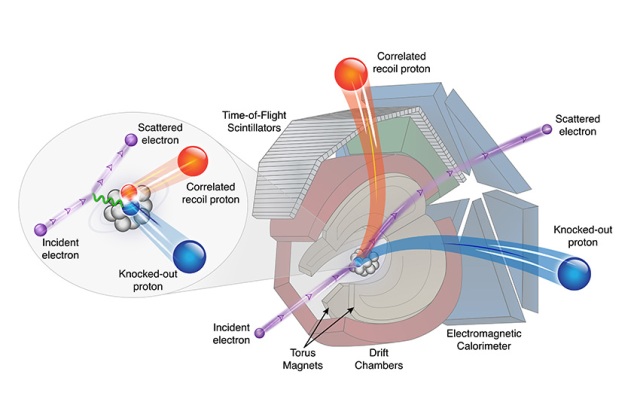May 30 2015
Like dancers swirling on the dance floor with bystanders looking on, protons and neutrons that have briefly paired up inside an atom’s nucleus have a higher-than-average momentum, leaving less energy for non-paired nucleons.
 Illustration of Jefferson Lab's CEBAF Large Acceptance Spectrometer (CLAS), along with an event reconstructed from the data. In this experiment, an incident 5-GeV electron scatters from a nucleon (a proton or a neutron) that has briefly paired up with another. As particles flying out of the target enter the CLAS, their paths are bent by a magnet and measured by successive layers of different types of particle detectors. Image courtesy of Jefferson Lab
Illustration of Jefferson Lab's CEBAF Large Acceptance Spectrometer (CLAS), along with an event reconstructed from the data. In this experiment, an incident 5-GeV electron scatters from a nucleon (a proton or a neutron) that has briefly paired up with another. As particles flying out of the target enter the CLAS, their paths are bent by a magnet and measured by successive layers of different types of particle detectors. Image courtesy of Jefferson Lab
This phenomenon allows more protons than neutrons to have high momentum in a relatively neutron-rich nuclei, which is contrary to long-accepted theories. Using data from nuclear physics experiments carried out at the Department of Energy's Thomas Jefferson National Accelerator Facility, researchers have shown – for the first time – that this phenomenon exists in nuclei heavier than carbon, including aluminum, iron, and lead.
The Impact
The results of this study show that the Pauli exclusion principle, long used to describe the distribution of protons and neutrons in nuclei, does not accurately describe proton-neutron pairing. These results could change our understanding of the internal structures of systems where these pairings occur, including neutron stars.
Summary
In 2008, researchers obtained direct evidence that protons and neutrons in light nuclei (up to carbon, with six each protons and neutrons) pair up briefly in the nucleus, a phenomenon called a short-range correlation. In this pairing, protons preferred neutrons to other protons by 20 to 1. The protons and neutrons involved in a short-range correlation carry higher momentum than unpaired ones. Now, researchers have extended that result into heavier, neutron-rich nuclei, including aluminum (13p/14n), iron (26p/30n), and lead (82p/126n). They found that in these imbalanced nuclei, the minority protons tended to more likely to be found in a short-range correlation than the majority neutrons. The result comes from an initiative in which data from a completed experiment conducted in 2004 were re-analyzed to look for this phenomenon. It was made possible by the CEBAF Large Acceptance Spectrometer (CLAS) that was used to collect the data. The CLAS detectors almost completely surround an experimental target and can collect more than 2 terabytes of data a day. The result can likely be extended to other imbalanced systems, such as the atoms in ultra-cold atomic gases and in the cores of neutron stars.